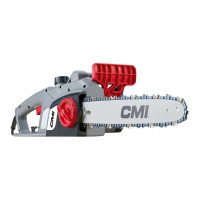GB
52
– If the chain brake is not working correctly,
have the device checked by an expert
immediately.
Filling up saw chain oil
► P. 4, item 6
– Lay device securely with the tank
cover (11) upwards.
– Before opening, clean the tank cover and
the filler neck if necessary.
– Slowly open and remove the tank cover.
– Carefully fill up the saw chain oil. Do not
spill!
– Read the oil level at the inspection
glass (7). The oil stand must be placed
between [MIN] and [MAX].
– Tighten the tank cover by hand.
– If you have spilled any saw chain oil, be
sure to wipe it up.
Operation
Safety equipment
The device has several pieces of safety
equipment which reduce the risk of injury
when working:
Claw stop
The claw stop enables the motor block to be
secured to the wood when using pull saws.
Uncontrolled kickback of the saw is thus
made more difficult. The process also exerts
pressure on the saw chain thanks to the gen-
erated leverage.
Chain catcher
The chain catcher serves to catch a torn saw
chain or one which has jumped out of the
guide. Through regular maintenance of the
saw rail and correct and regular tensioning of
the saw chain, accidents of this type can be
prevented.
Rear hand guard
The rear hand guard serves to protect the
hand against a jumped chain and disturbing
branches and twigs.
Check before starting!
Check the safety equipment and the safe
condition of the device.
– Check all parts for their firm fit.
– Check whether there is any leakage.
– Check whether there are visible defects:
broken parts, cracks, etc.
– Check the device for correct chain ten-
sioning.
– Check the function of the chain brake.
Attaching the extension cable
► P. 4, item 7
– Plug the unit plug into the connector of the
extension cable.
– Feed the extension cable through the
strain relief mechanism (14) as shown.
NOTICE! Environmental damage!
Since the saw chain oil can penetrate
the environment during operation,
biologically-degradable special vege-
table-based saw chain oils should be
used.
DANGER! Risk of injury! The
device must only be put into operation
if no faults are found. If any part of the
device is defective, it must be
replaced before the next use.

